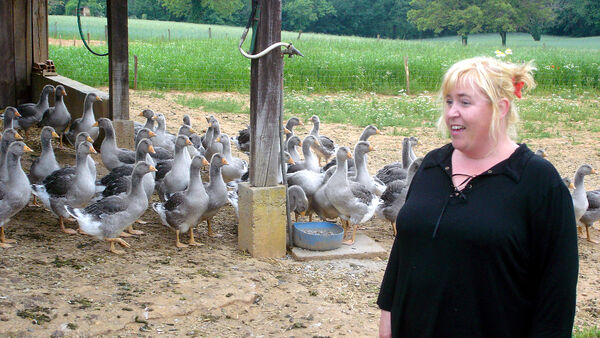The Dordogne’s Well-Fed Geese
By Rick Steves
Elbows on a rustic windowsill at a farm in the Dordogne region, I lose track of time watching Denis grab one goose at a time from an endless line. In a kind of peaceful, mesmerizing trance, he fills each one with corn. Like his father and his father’s father before him, Denis force-feeds geese for a living. He spends five hours a day, every day, all year long sitting in a barn on a rolling stool with a machine that looks like a giant vacuum cleaner, surrounded by geese.
Denis rhythmically grabs a goose by the neck, pulls him under his leg and stretches him up, slides the tube down to the belly, and fills it with corn. He pulls the trigger to squirt the corn, slowly slides the tube up the throat and out, holds the beak shut for a few seconds, lets that goose go, and grabs the next.
When I tell friends I’ve witnessed geese being force-fed—the traditional way their livers are fattened to make foie gras, the prized delicacy in the Dordogne—many of them express disgust. Many people refuse to buy French foie gras for what they consider inhumane treatment of the geese. That’s why I’m on Denis’ farm: to learn more about la gavage (as the force-feeding process is called) with a firsthand visit.
Elevage du Bouyssou, a big homey goose farm a short drive from Sarlat, is run by Denis and Nathalie Mazet. Their geese are filled with corn three times a day for the last months of their lives. They have expandable livers and no gag reflex, so the corn stays in there, gradually settling as it’s digested and making room for the next visit from Denis and his corn gun.
While Denis squirts corn, Nathalie meets tourists—mostly French families—who show up each evening at 6 p.m. to see how their beloved foie gras is made. The groups stroll the idyllic farm as Nathalie explains how they raise a thousand geese a year. She emphasizes that the all-important key to top-quality foie gras is happy geese raised on quality food in an unstressed environment. They need quality corn and the same feeder. To his geese, Denis is no threat.
I join the group as we scatter seed for the baby geese. We stroll into the grassy back lot where the older geese run free. Backlit by the low early-evening sun, they glow in rich colors.
The Mazets sell every part of the goose except the head and feet. The down feathers net less than a euro per goose—the serious money is in the livers. A normal goose liver weighs a quarter-pound, but after the force-feeding process is finished, a goose liver weighs about two pounds. With a thousand geese, they produce a ton of foie gras annually. “Barely enough to support one family,” Nathalie says.
These mature geese actually have a special shape, like they’re waddling around with a full diaper under their feathers. This fattened goose silhouette has become a sales icon in shops throughout the Dordogne. Just the sight of it is enough to make English travelers salivate. They come here in droves for the foie gras.
Why the Dordogne? This region in southwest France is on the birds’ migratory path southward. Ages ago, locals caught geese on their migration, with livers voluntarily enlarged in anticipation of the long journey. As the French are inclined to do, they ate the innards, found them extra tasty, and decided to produce their own. Those first French foie gras farmers didn’t know it, but they weren’t the first to keep geese and enlarge their livers for human consumption. Le gavage goes back to ancient Egyptian times.
When I tell Nathalie that some of my American readers will say I’ve been duped, she reminds me that their geese are calm, in no pain, and designed to take in food in this manner, while American farm animals are typically kept in little cages and fed chemicals and hormones to get fat. Most battery chickens in the US live less than two months and are plumped with hormones. Nathalie’s free-range geese live six months.
Dordogne geese live their lives at least as comfy as the other farm animals that many people (so upset with the foie gras process) have no problem eating. They are slaughtered as humanely as any non-human can expect in this food-chain existence.
After a few days in the Dordogne, where markets are filled with zealous farmers passing out little goose-liver sandwiches and where every meal seems to start with foie gras, I always leave with a strong need for a foie gras detox—and a strong desire to return soon.
This article was adapted from Rick’s new book, For the Love of Europe.

